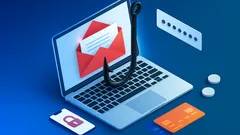
Think that your Mac is free of viruses? Beware. It's not. AMOS malware—which has been making rounds in tech circles recently—has received an upgraded version that's powerful. This isn't just another technology security issue: for anyone who uses a MacBook or iMac, the dangers have never been greater. Are you curious about how this hidden danger made its way onto screens across the globe? Find out the full story here and learn how you can be safe from danger before it finds you.
What Is the AMOS Malware and Why Does It Matter?
The AMOS virus, often known as Atomic Stealer, is a sophisticated malware designed specifically for macOS. In contrast to typical viruses that aim at mass infection, AMOS focuses on stealing sensitive information—think passwords, crypto-wallet data, and credit card information—from ordinary users. With the recent upgrade, AMOS has now managed to get past many of the security features included in Mac systems. This means that even the computer that's widely regarded as "virus-proof" has a new digital adversary.
Key Ways AMOS Infects Macs
AMOS is typically spread via malicious downloads, fake application installers, and fraudulent emails. Researchers have found that tactical attacks using phishing as well as seemingly harmless software updates are spreading this malware more efficiently. More than 60% of attacks during the last 3 months were after users opened attachments or clicked "update" on non-official websites.
"AMOS marks a shift in cybercriminal focus, making Mac users just as vulnerable as Windows users," cybersecurity analyst Jane Phillips notes.
What Makes This Update So Dangerous?
The most recent AMOS version is loaded with new features. It not only scrapes the browser's data and saved logins, but it also has the ability to detect verification codes used for two-factor authentication. Imagine thinking you're protected by layers of security and then having your passwords stolen within a matter of minutes. This update makes AMOS more likely to bypass detection software, which keeps some users from being aware until their data is gone.
Spotting the Signs: Is Your Mac Infected?
The first signs of AMOS infection may not be obvious, but you should be alert for these warning indications:
- Browser pop-ups asking for unexpected logins
- Unusual resource or battery drain
- Difficulty logging into shopping or banking accounts
- Unauthorized purchases or missing digital funds
If you notice two or more of these, immediately take action to ensure your device is secured.
How To Stay Safe From Mac Malware
Staying ahead of the curve isn't as difficult as you think. Here's a quick guideline to protect your Mac against malware:
- Install applications only through the official App Store
- Keep macOS and all software up to date
- Create strong, unique passwords for each account.
- Be wary of unreliable or urgent "security updates"
- Set up two-factor authentication devices from trusted vendors
- Consider professional antivirus software designed specifically for macOS
AMOS malware is constantly evolving and digital security is not a simple matter to fix and forget. Good habits are the key to success.
Why You Shouldn't Underestimate the Threat
It's a hard pill to swallow, but the age of "Macs can't get viruses" is over. With more than 17 percent of US households currently using Mac computers, cybercriminals are finding an increasing demand for their services. About 30 percent of Mac users have not yet installed antivirus software, according to recent studies. The myth of bulletproof Apple security is quickly disappearing, which makes it all the more important to stay aware.
If you've ever considered, "how do I remove malware from my Mac," you're not alone. Many are awakening to the fact that current macOS security threats require real solutions, not hope. Being alert, observing best practices, and sharing information with others are the only ways to keep our online lives secure. Remember that in the world of cybersecurity and technology news, what you don't know could hurt you.
 W3 CodeCraft
W3 CodeCraft















Comments